Intro
1515! A date that resonates in the memory of all schoolchildren in France like a cannon shot. It refers to a prestigious victory:Marignan; and to one of the greatest kings of France:François Ier. Endowed with a remarkable political sense, François I reinforces the royal authority by laying the foundations of a centralized State. He is also known as "the Prince of the Renaissance", the privileged instigator of the introduction of the Italian Renaissance in France. This beginning of the 16th century was marked by two important conflicts:
- The Italian Wars
- The struggle against the empire of Charles V
Louis XII
The reign of Louis XII
Louis XII is the son of Charles d'Orléans, the poet prince, and Marie de Cleves. He is therefore the great-grandson of Charles V. Orphaned by his father at the age of 3, he is taken into guardianship by Louis XI who was very hard on him. Indeed in 1476, he forced him to marry his youngest daughter Jeanne de France. However, the latter is deformed, physically deficient, and probably sterile. Louis XI thus hoped to bring about the extinction of the Orleans branch, which still threatens the elder branch of the Capetians. At the time of the wedding, Louis XI, always cynical, moreover slipped to one of his confidants "... for what it seems to me that the children they will have together will not cost them dearly to feed...” . On the king's death, Louis d'Orléans failed to obtain the regency at the Estates General of Tours, which was taken by Anne de Beaujeu (daughter of Louis XI). He then allied himself with the princes of the kingdom to oppose the Regent. This four-year confrontation (1484-1488) bears the name of mad war. Beaten at Saint Aubin du Cormier in 1488, Louis d'Orléans was imprisoned for three years in very harsh conditions. Pardoned, he follows his cousin, King Charles VIII, to Italy where he tries in vain to conquer the Duchy of Milan for his own benefit. He succeeded Charles VIII in 1498, who died accidentally with no surviving children. Having become king, Louis XII hastens to have his marriage with Jeanne of France annulled by the Pope for non-consummation, the unfortunate Jeanne therefore retires to the convent in Bourges. She later founded the order of nuns of the Annonciade, and was canonized by Pope Pius XII in 1950. Louis then married the widow of Charles VIII, Anne de Bretagne. He administers his domain with intelligence. It uses tax revenue for the good of the country by maintaining the road network. Enjoying great popularity, he is called the "Father of the People".
The Italian Wars
The Italian Wars are conflicts waged by French sovereigns in Italy to assert their hereditary rights over the Kingdom of Naples, then over the Duchy of Milan.
- The House of Anjou, a younger branch of the Capetians, reigned over Naples until 1442. At that time, the kingdom was occupied by the Aragon family. After the death of René d'Anjou, the inheritance rights of the Duchy of Naples pass to the King of France.
- Louis XII, successor of Charles VIII, is the grandson of a Visconti, ducal family of the city of Milan. The King of France is thus interested in the duchy.
List of Italian wars:
- Charles VIII
- First Italian War (1494-1497)
- Louis XII
- Second Italian War (1499-1500)
- Third Italian War (1500-1504)
- Fourth Italian War (1508-1513)
- Francis I
- Fifth Italian War (1515-1516)
- Sixth Italian War (1521-1526)
- Seventh Italian War (1526-1529)
- Eighth Italian War (1536-1544)
- Ninth Italian War (1543-1545)
- Henry II
- Tenth Italian War (1547-1556)
- Eleventh Italian War (1556-1559)
The Italian expeditions of Louis XII
- Following an alliance between Venetians and French, Louis XII seized the Duchy of Milan in 1500. He took the Duke of the city prisoner:Ludovico le More. From this strategic position, Louis XII wanted to descend on Naples, as Charles VIII wanted. For this, the king made an alliance with Ferdinand II of Aragon, and together they seized all of southern Italy in 1501. However, following a disagreement over the division of lands, the Franco alliance -Spanish breaks. Ferdinand of Aragon thus forced the French to leave Naples in 1504. Louis XII signed the Treaties of Blois in which he renounced his claims to Italy.
- In 1507, the city of Genoa rose up, and Louis XII was able to intervene again in Italy (fourth war). The league of Cambrai including the papacy, France and the Holy Empire opposes the powerful city of Venice. The French won the victory of Agnadel in which a certain Bayard already distinguished himself. Louis XII immediately seizes the Lombard towns which belong to him, the Emperor Maximilian does the same with his own and Pope Julius II occupies Romagna. However, worried about the progress of Louis XII, Pope Julius II expressed his desire to drive him out of Italy. Bayard then fights the armies of the pope, and this with success. Meanwhile, Louis XII organizes a council with the aim of deposing Julius II. The latter unites the Holy League with Spain and Venice, then England and the Swiss cantons, against France. The French, under the command of Gaston de Foix, defeated the Spaniards at Ravenna in 1512. But the knight was killed there, and his successor lacked his talents as a general. The French gave way under the onslaught of the Swiss in Novara and Louis XII thus lost all his Italian possessions. In 1514, Louis XII, now a widower, signed the Treaty of London with England. He then married the daughter of the King of England, Marie. Louis XII died three months later. He is buried in Saint Denis, with Anne de Bretagne. He leaves only two daughters, one of whom, Claude de France, is married to his designated successor:François d'Angoulême.
Louis XII
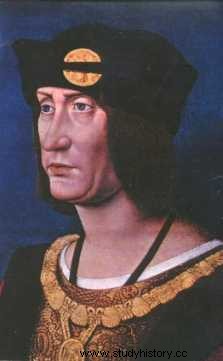
Francis I:A young and victorious king
The accession of Francis I
François, Duke of Angoulême, is a handsome cavalier, tall in stature and broad in build. He loves hunting, luxury, women who love his gallantry and presence. He was twenty years and four months old when the death of the reigning sovereign was announced on January 1, 1515. For a long time, Louis XII, without male descendant, had planned that François, his cousin would succeed him, and had given him in marriage his daughter, the sweet Claude of France. The latter owns through her father the Milanese, Genoa, Burgundy and Brittany. She was first engaged to Charles of Habsburg, the future Charles V. But, at the States General of Tours in 1506, aware of the threat of the future emperor, Louis XII reacted by canceling the engagement of his daughter in favor of François. Sacred in Reims on January 25, François first of the name, entered Paris and then led the court to the Loire Valley. Although he was not yet fully experienced in the functions of king, François I knew how to surround himself with effective people. The court that the king reestablished in Paris, by building the new Louvre, was the real heart of power. His mother, Louise of Savoy, enters the Privy Council, she will be twice regent of the kingdom. François I is grateful to the people who served Louis XII:la Trémoille, de Lautrec and de La Palisse. Until 1541, Anne de Montmorency, appointed first gentleman of the king's chamber, enjoyed royal favor and a dazzling career.
The salamander, emblem of Francis I
The salamander, emblem of François I, symbolizes power over fire, therefore over men and over the world. The motto Nutrisco &extinguo ("I feed on it and I extinguish it"), which sometimes accompanies this emblem, takes on its full meaning when referring to power over fire. It is found on a lot of ceilings and walls of the Château de Chambord and on the arms of the city of Le Havre. This somewhat magical animal is supposed to put out bad fires and kindle good ones.
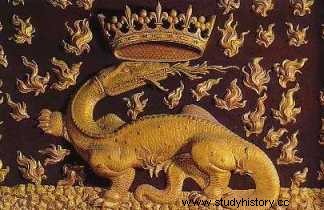
The Battle of Marignan
Barely crowned, François I joined his army of 300,000 men in Lyon. His goal is to take over the Duchy of Milan (just like his predecessor). In a few days, he made him cross the Alps at the Col de Larches. Remarkable exploit for the time with such an army equipped with a formidable artillery of 120 pieces. Artillery is the number one asset, it is the first in Europe. He arrives in front of Milan with his entire army, his adversaries negotiate. The king thinks he has satisfaction without fighting. Suddenly on September 13, the Milanese leave the city and push the royal army. The bulk of their troops is made up of the best infantry in the world, that of the Swiss, who hire out their services as mercenaries. The latter attack the lansquenets which protect the artillery. The three squares of pikemen (7,000 to 8,000 men per square) make them bend but the king comes to support them. The Chevalier Bayard, fights with great bravery. His horse is killed under him. He gets back in the saddle immediately; the bridles severed, his second mount races and drags him towards the Swiss ranks. But he escapes in time and returns to his camp through the vineyards. The troops hold out until midnight, then the fight stops. In the early morning of the 14th, the fight resumed. The French artillery commanded by the Seneschal of Armagnac wreaked havoc but the left wing of the king's army commanded by the Duke of Alençon gave way. The arrival of Venetian reinforcements allied with the French got the better of the Swiss. They leave the battlefield of Marignan, abandoning 20,000 dead and prisoners. François I is knighted on the battlefield by Pierre du Terrail, Lord of Bayard. The Milanese is reconquered. The league of Italian princes falls apart, negotiations begin. The following year, in Bologna, Pope Leo X accepted a concordat which regulated the affairs of the Church of France:the king alone had the authority to designate the bishops and abbots in his kingdom. The Battle of Marignan, at the dawn of the reign of François I, has become a symbol of the king's glory. The defeat of the Swiss is an event, because they have acquired, through their discipline, a reputation for invincibility. A perpetual peace is signed with the latter:they undertake not to serve any more in armies which would make war on the king of France. In return, the king regularly raises troops of mercenaries for his military campaigns. This peace has never been broken.
Knight Bayard
Born near Grenoble in 1465, Pierre de Terrail, Lord of Bayard, served his apprenticeship as a young nobleman as a page with the Duke of Savoy; then he went into the service of the kings of France. He will become the “Knight without fear and without reproach”. Always, his name has been synonymous with unparalleled bravery, total loyalty to his king and chivalrous spirit. In the kingdom of Naples, at the bridge of the Garigliano, he held alone a troop of 200 Spaniards. Prisoner twice, he is freed without ransom by his enemies who admire him. He refuses to participate in the looting of cities and protects non-combatants against violence. Bayard is a brilliant man of war who contributes to the victory of Marignan, and who, in 1521, defends the city of Mézières against Charles Quint and forces him to retire. When he was mortally wounded, in 1524, while protecting the retreat of the French army from Milan, his adversaries came to show him their respect.
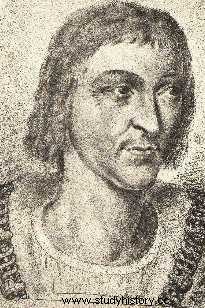
Portrait from the book "History of Bayard, Le Loyal Servant", Librairie Hachette, 1882, from the original kept in the Grenoble library.
The kingdom of Francis I
A mighty kingdom
François I inherited the most coherent kingdom in Europe, even if the institutions coming from the Middle Ages singularly complicate the royal government:privileges of the provinces, seigniorial powers still very powerful, like those of the constable Charles de Bourbon who reigns almost like a king on the Center. France covers approximately 450,000 km² and has 15 to 18 million inhabitants, which makes it the most populated country in Europe. Foreigners envy the wealth of France. It exports its grains, its wines, salt, cloth... Each year, thousands of peasants and craftsmen go to work in Spain from where they return with their pockets lined with beautiful coins minted in the silver sent South America. Because Spain and Portugal founded immense colonial empires. The French in turn began to explore the seas:in the year 1534, Jacques Cartier landed in Canada. To better open the kingdom to the Atlantic, the king founded Le Havre in 1537. From Dieppe, the navigator and shipowner Jean Ango sent his ships on the spice routes; better still, he races against the Spanish and Portuguese galleons laden with treasures. At that time, when 90% of French people lived in the countryside, Paris, with its 200,000 inhabitants, was considered a monstrous city. Lyon, which has become a major business centre, has 50,000 inhabitants who are enriched by fairs, banking activities, silk manufacturers and the sixty printing works which make it the European capital of books. From this rich, active, well-populated France, the king drew enormous resources. And carrying... Maintaining a court that reaches up to 15,000 people and an army of mercenaries, the expenses that the royal constructions require, all this causes the king to be constantly short of money. Peasants and small townspeople are subject to many taxes, the heaviest of which are the tax and the gabelle; the clergy had to agree to pay large sums, but too many privileged people unjustly escaped the tax. The king cannot get more.
The Americas
The king in 1524 helps the Florentine merchants installed in Lyon then Jehan Ango, the Dieppe shipowner, to finance the expedition of Giovanni da Verrazano in North America; during this expedition, Verrazano maps Newfoundland, then founds New Angoulême (the future New Amsterdam, better known as New York) in homage to the family of the King of France. In 1534, he sent Jacques Cartier to explore the St. Lawrence River in Quebec to discover “certain islands and countries where it is said that a great quantity of gold and other rich things must be found”.
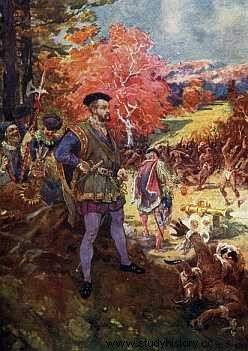
Jacques Cartier ordering cannon fire to impress the Indians - Engraving after H. SANDHAM
The organization of the kingdom
François Ier is an obeyed king, the royal government is organized and gains in efficiency. The royal councils specialize:the constable (head of the armies) and the chancellor (head of justice and administration) have strong authority. The king multiplies the officers, civil servants who buy their charges. They are between 8,000 and 9,000 at the end of the reign. Thanks to them, justice and royal finances are managed as less badly as possible. Among the many royal decisions (more than 30,000), we note the Edict of Villers-Cotterêts (1539) . Thanks to him, each priest must keep a birth register up to date, this is the beginning of civil status in France and the first registrations with filiation in the world. The same ordinance makes French the official language of administration and law instead of Latin. Some say absolute monarchy begins with Francis I. The institutions he put in place enabled his successors to further strengthen their authority. The nobility remained vigilant about maintaining their privileges, but the king managed to get rid of his greatest lord:Charles de Bourbon, who left to serve Charles V. Parliaments, too, can balk. These powerful courts exercise a right of remonstrance over royal decisions and sometimes refuse to register them. Another disturbing factor is the proliferation of Reformed (Protestants). The king is very tolerant towards them, but he cannot finally bear that they endanger the moral unity of the kingdom. In 1540, the Edict of Fontainebleau authorized systematic persecution. It is not yet a civil war, but serious violence is exerted.
Francis I
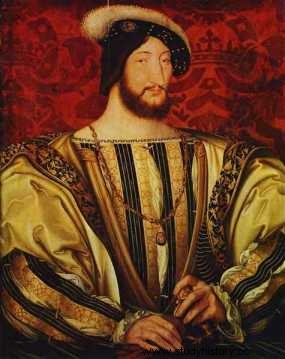
Francis I, by Jean CLOUET
The fight against Charles V
A powerful adversary
At twenty-two, Francis I could appear to be the most powerful sovereign in Europe. But he had to face two other kingdoms:
- King Henry VIII's Kingdom of England
- But above all, the empire of Charles de Habsbourg, known as Charles V
In 1519, Charles, who was not yet twenty years old, reigned over the Netherlands, Austria, Spain and its colonial empire. On the death of Maximilian of Habsburg, his grandfather, a new emperor had to be elected to govern the mosaic of states and principalities that Germany represented. Charles intended to succeed him. But Francis I also applied to seven German Prince Electors. Charles was elected and took the title of Charles V, June 28, 1519. It cost him the equivalent of two tons of gold that had bought the votes of the Electors. Francis I, had wasted a ton and a half of gold there. The title was prestigious and the failure was cruel for the King of France. Faced with the overwhelming power of Charles V, François I sought allies. Italy being hostile to him, he turned to the King of England, Henry VIII. In May 1520, the two young sovereigns met near Boulogne-sur-Mer, in the extravagant Camp du Drap d'or. Assaults of elegance, superb feasts, balls and tournaments, nothing is missing from these long days of celebrations. The castles are assemblages of painted canvases, François I and his retinue lodge in a city built of tents with precious fabrics. The two sovereigns swear friendship:fifteen days later, Henry VIII joins forces with Charles V!
Charles V and the Habsburg Empire
To understand how Charles V was able to arrive at the head of an immense empire and become the most powerful Christian monarch of his time, it is necessary to look at his genealogy since his grandparents all gave him a title:
- Paternal side (Philip I the Handsome)
- Emperor of the Holy Roman Empire (Maximilian of Habsburg)
- Duke of Burgundy (Mary of Burgundy, daughter of Charles the Bold)
- Maternal side (Mad Jeanne)
- King of Spain (Isabella I of Castile + Ferdinand II of Aragon)
- King of Naples, Sicily and Jerusalem (Ferdinand II of Aragon)
Religious wars and the pugnacity of Kings Francis I and Henry II finally put an end to the realization of Charles V's Carolingian dream. The Habsburgs remained a powerful dynasty in Europe thereafter until the 20th century.
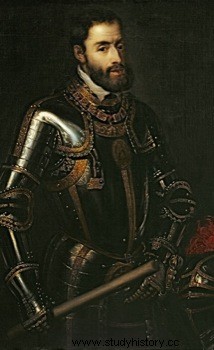
Charles V, by Titian
An endless struggle
François Ier cannot accept the omnipotence of Charles Quint; in the same way the latter is assured of his power in Europe only if he comes to the end of the richest and most populous kingdom. Francis I immediately declared war on him; but he experienced only setbacks:in 1521, Chevalier Bayard defended Mézières besieged by the German troops of Charles V; after the defeat of Odet de Foix at the Battle of La Bicoque (1522), the retreat of Bonnivet, defeated at the Battle of Biagrasso, and the loss of Chevalier Bayard, he was himself defeated and taken prisoner at the Battle of Pavia (1525). It was his most terrible defeat:the French had done "prodigies of valor" in this fight; the king would have written to his mother:"All is lost, fors l'honneur" . Francis I is held prisoner for a year in Madrid and is forced to make important concessions in order to be released against the imprisonment for four years of his two eldest sons, the Dauphin François of France and Henri of France (future Henri II) . He recovered his freedom only by an onerous treaty signed in Madrid in 1526, by which he undertook in particular to cede Burgundy, Flanders and the Duchy of Milan to Charles V. However, on his return to France, François pretends that his agreement was obtained under duress and denies it. The royal children after a harsh detention are released against a large sum of money. The Burgundians refused to secede from France and the war began again almost immediately. Charles V cannot raise enough regular troops to crush his rival. Francis I, in fact, knew how to rely on all the resources of his kingdom:he recruited mercenaries and bought English neutrality at a high price for years. As a prince who understood the teachings of Machiavelli, he allies himself with the German princes whose revolts threaten the emperor. They are however reformed, the same ones who are persecuted in his own kingdom. Even more daring:he allies himself with the Turks whose armies nevertheless threaten Vienna and Germany. In 1547, on the death of the King of France, the kingdom was intact. It is a conflict of two centuries which has only just begun:the struggle of France against the weight of the sovereigns of Spain and Austria.
Francis I and the Turks
Under the reign of Soliman II, known as “the Magnificent” (1520 - 1566), the Turkish Empire extended from Iran to present-day Morocco. In Europe, his armies conquer Hungary and besiege Vienna. Against this triumphant enemy, Charles V mobilizes all the resources of the Christian world. What a scandal in 1535 when we learned of the alliance between François Ier and the sultan! The French will be able to reside in the Turkish Empire, to travel there, to trade; and the Turks will attack the king's old enemy from the east. Outraged, Christianity witnessed the siege of Nice by Franco-Turkish troops (1543). During the winter, in Toulon, thousands of inhabitants are dispersed to welcome these strange Muslim allies into their homes.
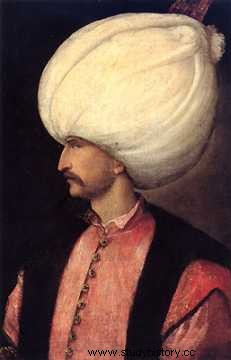
Suleiman II the Magnificent
The Prince of the Renaissance
The Italian influence
A king of this time is a moving king. He travels for his pleasure, but also to know his kingdom and get closer to his subjects. Always on the move, he takes with him the immense crowd of the courtyard; from 1531 to 1534, in particular, he traveled through France, from North to South. Regularly, festivals punctuate his travels:the cities organize solemn entrances where ballets, songs, decorations in praise of the king, everything adopts the new artistic expressions of this time. The castles where it stops are rebuilt, refurbished according to the teachings of Italy. The reign of François Ier is that of a great mixing of men and ideas; he is the king who naturalizes in France the Renaissance movement begun before him. While his two predecessors, Charles VIII and Louis XII, devoted much time to Italy's wars, they failed to grasp the artistic and cultural movement that was developing there. The contact between the Italian and French cultures during the long period of the Italian campaigns, introduced new ideas in France at the time when François received his education. His mother Louise de Savoie and his tutors, in particular Desmoulins, his Latin teacher, and Christophe de Longeuil instilled in the young François a teaching very inspired by Italian thought.
Letters and the arts
Under the reign of François I, secondary schools and colleges multiplied, where students were trained in the classical humanities. Although watched, and sometimes repressed, the printing press, in Paris and Lyon especially, takes a prodigious rise. The king requires that a copy of all the books appear in his library:this is the formation of the National Library. In 1530, he created, at his own expense, new, high-quality courses to improve the study of ancient languages and mathematics:this was the beginning of our Collège de France. Better known still, the role of François Ier as protector of foreign artists and king builder is spectacular. After Marignan, he brought Leonardo da Vinci back from Italy, whose Mona Lisa he kept after his death. He buys the Virgin on the rock from the painter Raphaël. Among all the artists he brought or received, the most illustrious are the sculptor and goldsmith Benvuto Cellini and the Primaticcio who, until his death (1570), was a sort of Minister of Fine Arts. And the king applied his talent to the development of the largest construction of the reign, that of the Château de Fontainebleau, where work was carried out from 1530 to 1570. In 1540, the work at Chambord, inaugurated twenty years earlier, was completed. In 1546, Pierre Lescot began the transformation of the Louvre by razing Philippe Auguste's castle and building the first walls of the Cour Carrée.
Leonardo da Vinci
François I showed a real affection for the old man whom he called “my father” and whom he installed at Clos Lucé, within reach of the royal castle of Amboise. He entrusted him with various missions such as the organization of court festivities in Amboise, the creation of costumes as well as the study of various projects. Vinci remained in France until his death, in the arms of the king according to legend.
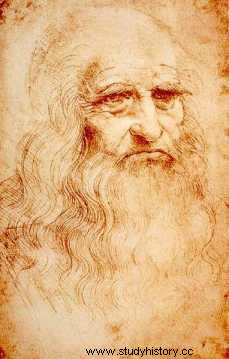
Leonardo da Vinci self-portrait at about 60 years old
The legacy of Francis I
François I died on March 31, 1547, at the age of 52. His tomb was desecrated during the Revolution. His dreams of conquests in Italy have caused him to waste many of the resources of his kingdom, but he leaves it intact. He could not defeat Charles V, but the Austrian and Spanish monarchy could not overcome this stubborn adversary. In thirty years, monarchical power has made considerable and definitive progress:absolute monarchy has become possible. The tolerance of François Ier, Christian king, did not however encourage him to follow the examples of the German or English kings:his kingdom will remain Catholic, massively. Prince of the Renaissance, he left behind him a country in full intellectual effervescence, where Rabelais completed his Gargantua, where the great characters competed with the king to build admirable palaces:Anet for Diane de Poitiers, Chantilly, Ecouen for the constable of Montmorency, Chaumont-sur-Loire, etc.
The Palace of Fontainebleau
The Château de Fontainebleau is a castle that was the residence of the sovereigns of France from François I to Napoleon III. Several kings have left their mark on the construction and history of the castle. François I decides to build a castle in the Renaissance style. He calls on Italian artists to ensure the construction and decoration of his palace. He comes to hunt at Fontainebleau, accompanied by his court and his mistress, the Duchess of Etampes. The king wanted to make Fontainebleau a center of Renaissance art:he collected works of art, commissioned works on mythology, brought antiques from Italy. He receives paintings from the pope and brings in molds of Roman statues in order to cast bronzes. Fontainebleau is sometimes referred to as the “New Rome”. During the French Revolution, the palace was emptied of its furniture; it successively became a barracks and then a prison. It was Napoleon I who revived Fontainebleau from 1804. Two evenings a week, he put on opera and theater performances. It was in Fontainebleau that Napoleon I signed his act of abdication in 1814. On April 20, he made a speech that remained famous in his custody in the Cour des Adieux. In the 19th century, Napoleon III's wife, Eugénie, spent her evenings in the small theater built by her husband.
The Palace of Fontainebleau
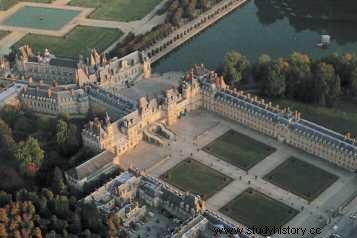
See also the page dedicated to the castles of the Loire
